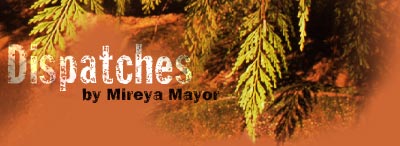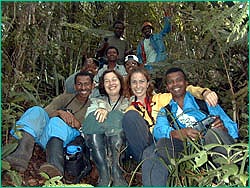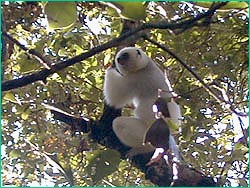 |
 
56k | ISDN Get RealPlayer software |
 June 1, 2000 Three Hours with the Silkies
Despite our best attempts to walk slowly and quietly, trying not to scare off the sifaka, we suddenly heard some lemurs directly over our heads. By the loud grunting sound they were making, we knew it was not the silky sifaka, but a group of seven white-faced brown lemurs. We got out our notebooks, noted what we'd seen, and continued our search. Shortly after, we came upon another group. Once again, they were not the sifaka, but rather the grey gentle bamboo lemur. The good news was that this particular species of lemur seems to enjoy the company of the silky sifaka, and they are often seen traveling together. Our guide whispered over our shoulders, "Maybe they are with the silky sifaka." We all looked and hoped, but once again, they were not. One of our goals for this study is to conduct a census in order to assess the number and kinds of lemurs that are in Marojejy National Park (which will be inaugurated on June 4th). To do this, we set up transects along the existing trails. Every 25 meters (82.5 feet), we post a small, bright-orange flag denoting how far we have walked from base camp. This helps identify exactly where we are when we find the animals and allows us to make reference to places where we have seen them. Once we have established transects, we walk quietly and stop every 50 feet to look up and around in the trees.
Over a half hour had gone by before we realized that they were not running away as they had done previously. Hour after hour they sat, dined on some of their favorite leaves (the young ones), and groomed one another, all the while paying no attention to us. At one point, they even hung suspended upside down by their hind feet and twined together in play. More than three hours later, they suddenly seemed to have had enough of their new-found friends and continued on their way to the sleeping tree where they would rest for the night. It was there that we left them all snuggled up to one another. We will be there early tomorrow morning, waiting for them to awake and continue their leisurely lives. Mireya Mayor is co-principal investigator with Pat Wright of this silky sifaka study at Marojejy National Park. Dispatches Forest of Hope (June 7, 2000) A Great Day for Silkies (June 4, 2000) Camp Life Unveiled (June 3, 2000) Three Hours with the Silkies (June 1, 2000) Angels of Marojejy (May 31, 2000) Wildlife (May 30, 2000) Into the Marojejy Massif (May 28, 2000) Croc Cave (May 26, 2000) Fossa! (May 25, 2000) Bat Cave (May 24, 2000) Update: English Camp (May 23, 2000) Update: Sunken Forest (May 21, 2000) Update: Night Walk (May 20, 2000) Update: 70 Feet Up (May 19, 2000) Update: Tropical Downpour (May 18, 2000) Photos: (1) Jacinth O'Donnell; (2) Mireya Mayor. The Expedition | Surviving The Wilds | Explore Madagascar Dispatches | Classroom Resources | E-Mail | Resources Site Map | The Wilds of Madagascar Home Editor's Picks | Previous Sites | Join Us/E-mail | TV/Web Schedule About NOVA | Teachers | Site Map | Shop | Jobs | Search | To print PBS Online | NOVA Online | WGBH © | Updated November 2000 |
 Pat
Wright's team in a celebratory mood after finding its second group of silky sifaka.
Pat
Wright's team in a celebratory mood after finding its second group of silky sifaka.
 A silky sifaka takes a siesta this afternoon after eating a lunch of
young leaves.
A silky sifaka takes a siesta this afternoon after eating a lunch of
young leaves.